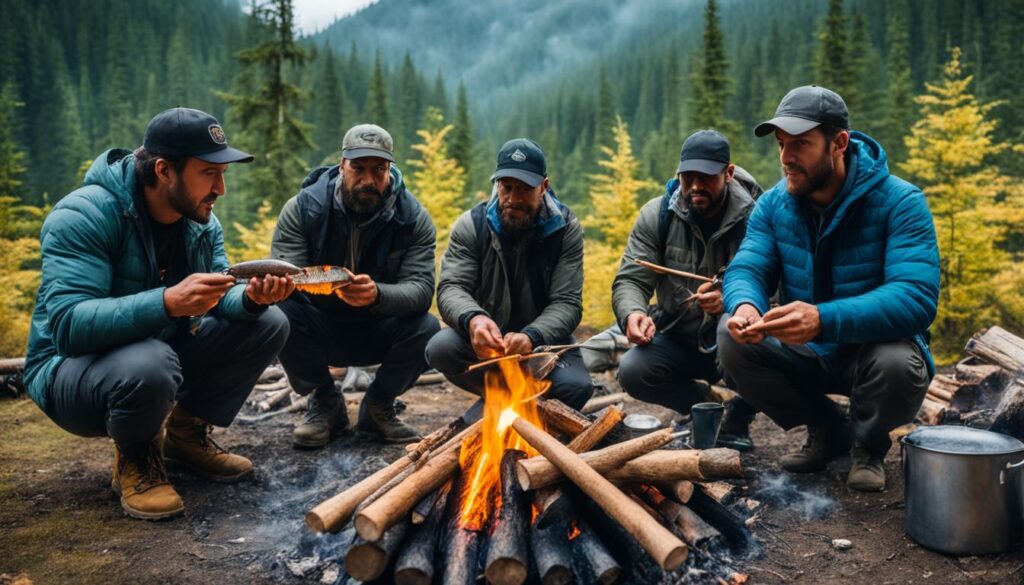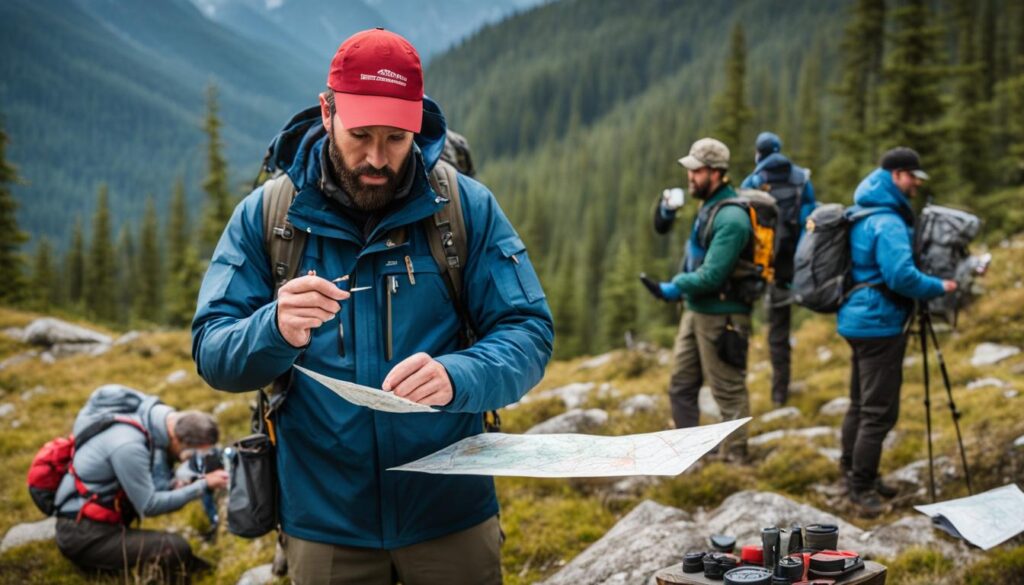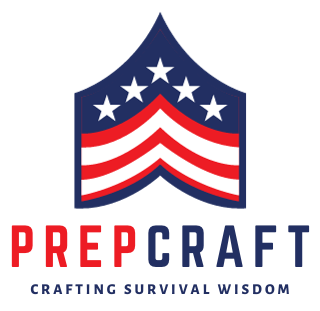
Welcome to the world of self-reliance education! In an unpredictable world, being prepared is not just a good idea, it’s essential. That’s where prepper courses and workshops come in. These hands-on training programs are designed to equip individuals with the skills and knowledge needed to thrive in challenging situations and be self-sustainable.
Self-reliance education is all about being prepared for whatever life throws your way. Whether it’s learning how to build a shelter, start a fire, find clean water, or navigate through unfamiliar terrain, prepper courses and workshops cover it all. These practical skills can make a significant difference in emergency situations, ensuring that you have the tools to survive and thrive.
Ready to take your self-reliance journey to the next level? Join us as we explore the world of prepper courses and workshops and discover the power of self-sustainability.
Key Takeaways:
- Prepper courses and workshops offer hands-on training in self-sustainability and emergency preparedness.
- Skills taught include first aid, shelter-building, fire-making, water procurement, food sourcing, and navigation.
- Survival training equips individuals with essential knowledge and skills to deal with emergencies and life-threatening situations.
- Being mentally and physically prepared is crucial for effective survival training.
- Becoming a certified survival instructor opens up opportunities to teach and share expertise with others.
Why Should I Take Survival Training?

Survival training is an invaluable investment in your safety and preparedness. In today’s unpredictable world, emergencies and life-threatening situations can arise at any moment. By equipping yourself with essential survival skills through training, you gain the knowledge and confidence to navigate these situations effectively.
Survival training covers a wide range of skills that are crucial for your survival and the well-being of those around you. Some of the key skills you will learn include:
- First aid: Knowing how to administer basic medical assistance can be lifesaving in emergency situations.
- Shelter-building: Proper shelter construction protects you from the elements and provides a safe haven.
- Fire-making: Fire is essential for warmth, cooking, and signaling for help.
- Water procurement: Understanding how to find, purify, and store water is crucial when resources are scarce.
- Food sourcing: Learning various methods of hunting, fishing, and foraging ensures you can sustain yourself in the wilderness.
- Navigation: Knowing how to read maps, use a compass, and navigate through different terrains is essential for finding your way.
These survival skills are not only applicable in wilderness environments but also prove essential during natural disasters, accidents, or any situation where help may be limited or unavailable. In distressing situations, having the knowledge and confidence to handle emergencies can be the difference between life and death.
“Survival training is not just about learning techniques; it’s about developing a mindset of resilience and adaptability.”
Testimonials
Here are a few stories from individuals who have benefited from survival training:
- “I never thought I would find myself in a situation where survival skills would be necessary. Thanks to the training I received, I was able to keep calm, treat injuries, and build a shelter when I became lost during a hike.” – Sarah
- “Survival training gave me the confidence to navigate a challenging river rapid when our canoe capsized. I was able to help my companions safely reach shore and start a fire to keep warm until help arrived.” – Michael
- “After experiencing a major natural disaster, the skills I learned in survival training allowed me to provide immediate aid to my family and neighbors, mitigating further damage and ensuring our safety until rescue teams arrived.” – Jennifer
These testimonials demonstrate the practicality and importance of survival training. By participating in a survival training program, you equip yourself with the necessary tools and knowledge to be self-reliant and resilient in any situation.
What Should I Do to Prepare For Survival Training?

To ensure a successful and effective experience in survival training, it is essential to be well-prepared both mentally and physically.
Mental Preparation
Survival training is designed to challenge individuals and teach them how to cope in demanding situations. To mentally prepare for survival training, it is crucial to have an open mind and be ready to embrace challenges. By maintaining a positive mindset and staying focused, you will be better equipped to respond to emergencies with a clear head.
“Survival training pushes your limits and helps you develop mental resilience. Embrace the challenges and stay positive.”
Physical Preparation
Physical fitness plays a vital role in survival training. Engaging in regular physical activities like hiking, walking, running, and strength training will help improve your overall fitness levels and stamina. Gradually increasing your pack weight will prepare you to handle the demands of survival situations where you may need to carry heavy loads.
| Physical Preparation Checklist |
|---|
| Engage in regular physical activities |
| Gradually increase pack weight |
| Improve overall fitness levels |
| Build stamina and endurance |
By focusing on both mental and physical preparation, you will enhance your overall experience and effectiveness in survival training. Being mentally resilient and physically fit will enable you to navigate and handle challenging situations with confidence.
How Do I Become a Certified Survival Instructor?

Becoming a certified survival instructor is an admirable pursuit that requires dedication and commitment. While prior expertise in survival skills is not mandatory, individuals interested in becoming certified instructors can enroll in comprehensive certification courses that provide in-depth education over several months. These courses cover various aspects of bushcraft and survival knowledge, equipping aspiring instructors with the necessary skills and knowledge to teach others effectively.
Becoming a certified survival instructor typically involves the following steps:
- Research and Choose a Certification Program: Look for reputable organizations or institutions that offer survival instructor certification courses. Ensure that the program covers a wide range of topics, including wilderness survival techniques, navigation skills, first aid and emergency response, and teaching methodologies.
- Enroll in the Certification Course: Once you have selected a suitable certification program, enroll in the course. These courses are usually intensive and may involve both online and practical training components. Be prepared to invest time and effort into acquiring the necessary knowledge and skills.
- Complete the Course Requirements: Engage actively in the course materials and practical training exercises. Follow the curriculum, participate in hands-on activities, and complete any assignments or assessments as required.
- Graduation and Certification: After successfully completing the course requirements, you will graduate and receive your certification as a qualified survival instructor. The certification affirms your proficiency in teaching essential survival skills and allows you to share your expertise with others.
Once certified, you can explore various avenues to apply your skills and knowledge as a survival instructor. Consider working with survival schools, outdoor education programs, summer camps, or community organizations that offer survival training. You can also conduct workshops, private lessons, or online courses to guide and educate individuals in basic bushcraft and survival skills.
Being a certified survival instructor enables you to empower others with essential life-saving knowledge and skills, fostering resilience and self-reliance in individuals of all ages. By sharing your expertise, you contribute to building stronger and more prepared communities.
Tips for Success:
- Continuously Enhance Your Skills: Stay updated with the latest developments in survival techniques and advancements in gear. Attend workshops, seminars, and conferences to expand your knowledge and refine your teaching methods.
- Develop Effective Communication Skills: As a survival instructor, effective communication is key to facilitating learning and ensuring student safety. Hone your communication skills to effectively convey instructions, clarify doubts, and maintain a positive learning environment.
- Gain Real-World Experience: Enhance your credibility as an instructor by gaining real-world survival experience. Participate in challenging outdoor activities, such as backpacking trips and wilderness expeditions, to sharpen your skills and gain practical insights.
| Benefits of Becoming a Certified Survival Instructor |
|---|
| Opportunity to educate and guide individuals of all ages in essential survival skills |
| Contribution to building self-reliant and resilient communities |
| Access to diverse teaching opportunities, including schools, camps, and community programs |
| Continuous personal growth through ongoing skill development and knowledge acquisition |
| Satisfaction of empowering others and helping them become better prepared for emergencies and outdoor adventures |
Can Kids Do Survival Training?
Survival training is not limited to adults; it is beneficial and encouraged for kids as well. Engaging in youth survival training courses equips children with essential skills that can increase their odds of survival in emergency situations. However, the benefits of youth survival training go beyond just survival skills.
Participating in survival training at a young age has numerous advantages for children. It builds character, instills a sense of responsibility, fosters outdoor appreciation, and promotes camaraderie among peers. Learning to navigate through challenging situations and overcome obstacles in a safe and controlled environment helps children develop resilience and self-confidence.
Moreover, youth survival training provides an opportunity for kids to disconnect from technology and experience the wonders of nature firsthand. It encourages physical exercise, enhances problem-solving abilities, and cultivates respect for the environment. By immersing themselves in the wilderness, kids learn about nature’s delicate balance and the importance of conservation.
Through hands-on learning and practical activities, youth survival training courses teach children fundamental survival skills such as shelter-building, fire-making, navigation, and basic first aid. These skills not only prepare them for outdoor adventures but also make them more self-reliant and capable of handling challenging situations confidently.
The Benefits of Youth Survival Training:
- Increases odds of survival in emergency situations
- Builds character and fosters responsibility
- Promotes outdoor appreciation
- Fosters camaraderie among peers
- Cultivates resilience and self-confidence
- Encourages physical exercise
- Enhances problem-solving abilities
- Promotes respect for the environment
- Educates about nature and conservation
- Teaches essential survival skills
- Makes children more self-reliant
- Develops the ability to handle challenging situations
By providing children with the opportunity to engage in survival training, we empower them to become more self-reliant and prepared for unexpected situations. Youth survival training is an investment in their future well-being, equipping them with practical skills and life lessons that will serve them throughout their lives.
| Benefits of Youth Survival Training |
|---|
| Increases odds of survival in emergency situations |
| Builds character and fosters responsibility |
| Promotes outdoor appreciation |
| Fosters camaraderie among peers |
| Cultivates resilience and self-confidence |
| Encourages physical exercise |
| Enhances problem-solving abilities |
| Promotes respect for the environment |
| Educates about nature and conservation |
| Teaches essential survival skills |
| Makes children more self-reliant |
| Develops the ability to handle challenging situations |
Engaging in youth survival training not only prepares children for emergencies but also empowers them with valuable skills and experiences that will shape their character and outlook on the world. By investing in their survival education, we contribute to their personal growth and equip them with the tools they need to thrive in any situation.
What Gear Should I Bring?
When attending survival training, it is essential to have the appropriate gear to ensure a successful and safe experience. The following is a checklist of essential survival gear that should be brought:
Clothing
- Sturdy hiking boots
- Moisture-wicking socks
- Long-sleeve shirts
- Insulated jacket
- Rain gear
- Wide-brimmed hat
- Gloves
Shelter and Sleeping
- Tent or tarp
- Sleeping bag
- Sleeping pad or air mattress
- Pillow
Fire and Light
- Firestarter or matches
- Lighter
- Headlamp or flashlight
- Extra batteries
Navigation and Communication
- Compass
- Map of the area
- Whistle
- Signal mirror
- GPS device or smartphone with GPS capabilities
Food and Water
- Water bottles or containers
- Water purification tablets or filter
- High-energy snacks
- Dehydrated meals
- Camp stove or portable cooking system
- Cooking utensils and pot
Tools and Miscellaneous
- Knife or multi-tool
- First aid kit
- Emergency blanket
- Paracord or rope
- Duct tape
- Binoculars
Having these essential survival gear items will ensure that you are well-prepared for any challenges and emergencies that may arise during your training. Remember to pack these items in a sturdy backpack or duffel bag for easy transportation. Stay safe and enjoy your survival training!
Conclusion
Self-reliance education is essential in today’s uncertain world. Prepper courses and workshops provide invaluable opportunities for individuals to enhance their survival skills and preparedness. Through hands-on training in crucial skills such as first aid, shelter-building, fire-making, water procurement, and navigation, participants gain the knowledge and expertise to thrive in wilderness environments and handle emergencies confidently.
By taking part in survival training, individuals become self-sufficient and self-sustainable. They learn how to rely on their own abilities and resources, making them well-equipped to face any challenges that may come their way. Whether it’s through mastering the art of building a shelter in the wilderness or developing the skills to navigate unfamiliar terrains, self-reliance education empowers individuals to overcome obstacles and emerge victorious.
Investing in self-reliance education and participating in prepper courses is a proactive step towards personal preparedness. In today’s rapidly changing world, being equipped with survival skills can mean the difference between life and death. Take the initiative to enhance your survival skills and be ready for any situation. Enroll in a prepper course, gain valuable knowledge, and empower yourself to thrive and survive.
FAQ
Why should I take self-reliance education courses and workshops?
Self-reliance education courses and workshops provide hands-on training in various aspects of self-sustainability, emergency preparedness, and disaster readiness. These courses enhance survival skills such as first aid, shelter-building, fire-making, water procurement, food sourcing, and navigation, equipping individuals to thrive in challenging situations.
What are the benefits of survival training?
Survival training provides individuals with essential knowledge and skills to deal with emergencies and life-threatening situations. By participating in survival training, individuals can learn crucial skills such as first aid, shelter-building, fire-making, water procurement, food sourcing, and navigation. These skills can be life-saving in wilderness environments and during emergencies.
How should I prepare for survival training?
To prepare for survival training, it is important to be mentally and physically prepared. Mentally, individuals should have an open mind and be ready to embrace challenges. Physically, engaging in regular physical activities like hiking and walking improves fitness levels and stamina. Gradually increasing pack weight to handle at least 50 pounds is recommended.
How do I become a certified survival instructor?
To become a certified survival instructor, individuals can enroll in certification courses that educate them over several months. These courses cover various aspects of bushcraft and survival knowledge and culminate in a certification graduation. Once certified, individuals can work with survival schools and programs across the country, teaching and sharing their expertise with others.
Can kids participate in survival training?
Yes, survival training is suitable for kids and is even encouraged at a young age. Youth survival training courses not only increase a child’s odds of survival in emergency situations but also build character, foster outdoor appreciation, and promote camaraderie among peers. These courses focus on teaching children basic survival skills in a safe and controlled environment.
What gear should I bring for survival training?
To ensure a successful and safe experience, it is important to have the appropriate gear for survival training. This includes essentials such as first aid kits, shelter-building materials, fire-starting tools, water procurement methods, navigation tools, and food sourcing equipment. It is recommended to consult a gear checklist to ensure all necessary items are included.
How can self-reliance education and prepper courses benefit me?
Self-reliance education and prepper courses provide individuals with the opportunity to enhance their survival skills and preparedness. These courses offer hands-on training in essential skills such as first aid, shelter-building, fire-making, water procurement, and navigation. By participating in survival training, individuals gain the knowledge and expertise to thrive in wilderness environments and handle emergencies with confidence.


